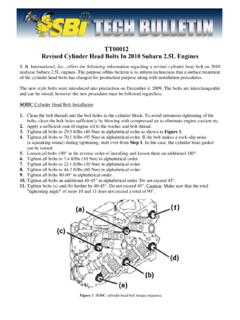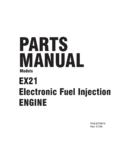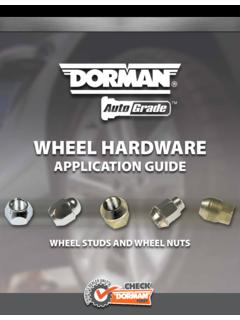Transcription of Subaru Lineartronic CVT Introduction - ATRA
1 Subaru Lineartronic CVT Introduction Presented by: Mike Souza ATRA Senior Research Technician Lineartronic CVT Webinar 2015 ATRA. All Rights Reserved. Introduction The Lineartronic CVT is an automatic continuously variable all wheel drive longitudinal transaxle. It provides an infinite step-less change in ratios from to 1 in the highest range all the way to to 1 in overdrive range. This AWD transaxle is equipped behind the new sporty Subaru Boxer engine in some models. All Wheel Drive Subaru Boxer Engine Lineartronic Introduction The Lineartronic -CVT can be found in these vehicles. 2010-15 Exiga F/AWD H4 / TR580 Gen II / TR690 Gen I (European). 2011-15 Forester AWD H4 / TR580 Gen II / TR690 Gen I. 2010-15 Impreza AWD H4 / TR580 Gen II / H4 TR690 Gen I. 2009-15 Legacy AWD H4 / H6 TR690 Gen I / H4 TR580 Gen II. 2009-15 Outback AWD H4 TR580 Gen II / H6 TR690 Gen I. 2014-15 WRX AWD H4 TR580 Gen II. 2013-14 XV Crosstrek AWD H4 TR580 Gen II. There are two versions of this transmission Gen I TR690 and Gen II TR580.
2 The more compact Gen II is 100mm shorter and 15% lighter than the Gen I. For the most part in this webinar we will be covering the Gen I models. Gen I TR690 / Gen II TR580. Generation I TR690. Generation II TR580. Gen I TR690 / Gen II TR580. There are 6 major differences with Gen II in comparison to the Gen I. 1. The Forward and Reverse shift mechanism is on the input side of power flow. 2. The Pulleys are not rotating in Park or Neutral (less engine parasitic drag). 3. The weight and load of the vehicle directly affects the Secondary Pulley operation. 4. Fail-safe gear ratio is common for Primary Up or Primary Down solenoid failures. 5. The Forward and Reverse Clutches can be heard activating until the Clutch Plates expand from heat. 6. The Valve Body assembly is located on the top of the transmission under the cover. Gen II TR580. Top Cover Valve Body Gen II TR580. Shallow Pan Linkage How Does It Work The driver can control up and downshifts through paddle switches located on the steering wheel and a console mounted floor shifter in the manual gate.
3 There are 3 shift control modes the driver can select which include automatic, manual and temporary manual. Automatic mode provides gear ratios from to 1 in the highest range on take off to to 1 in the lowest range in the overdrive ratio in the Drive range. The Lineartronic will step through preset ratios similar to a conventional automatic shifting transmission. In the less aggressive mode (Intelligent), the transmission changes through six preset ratios. Using the paddle switches on the steering wheel in Sport ( Sharp ) mode, and the transmission will change up to eight preset ratios. The paddle shifter provides control of the ratios, and a LCD screen between the analog speedometer and tachometer shows which ratio is selected. How Does It Work Manual mode provides the following 6 gear ratios: 1st :1 ( :1 in Auto Mode). 2nd :1. 3rd :1. 4th :1. 5th :1. 6th :1 ( :1 in Auto Mode). Reverse gear in all modes is :1. The highest ratio during take off is in the Manual Mode while the lowest overdrive ratio is in the Automatic Mode.
4 Manual mode is controlled by placing the console shifter into the manual gate and using the up and down paddle buttons on the steering wheel. Temporary manual mode can be accomplished anytime while in automatic mode by activating the paddle shift buttons on the steering wheel. How Does It Work Pulley Operation Secondary Pressure (Line) is the same in both Pulleys at all times. The purpose of secondary pressure is to squeeze the pulleys together to clamp the pulleys against the chain and keep it from slipping. The primary pulley receives engine power from the input clutch. The TCM adjusts the signal to the primary-up solenoid to change the ratio of the transmission. This alters the position of the primary-up control valve, which increases primary pressure in the ratio chamber. The added pressure in the ratio chamber squeezes the primary pulley together, making the chain ride up in the pulley, increasing the effective pulley diameter. At the same time, it forces the secondary pulley apart, reducing the effective diameter of the driven pulley.
5 This raises the effective gear ratio toward an overdrive range. Pulley Operation 1st :1 ( :1 in Auto Mode). The Primary Pulley receives Engine Power from the Input Clutch Low Gear Ratio Take Off Secondary Pressure (Line) is the same in both Pulleys at all times keeping clamping pressure to hold the Chain from slipping Pulley Operation 6th :1 ( :1 in Auto Mode). The Primary Pulley receives Engine Power from the Input Clutch High Gear Ratio Overdrive Secondary Pressure (Line) is the same in both Pulleys at all times keeping clamping pressure to hold the Chain from slipping Pulley Operation As the vehicle slows, the TCM sends a signal to the primary-down solenoid. The oil from the solenoid controls the primary-down valve, which dumps pressure through the ratio switch valve. As pressure drains from the ratio chamber in the primary pulley, spring force takes over in the secondary pulley. The spring squeezes the secondary pulley closed, effectively increasing its diameter. At the same time, it forces the primary pulley open, effectively reducing the front pulley's diameter.
6 This puts the transmission back into low gear range. The ratio changes up and down are smooth. This helps keep the engine RPM at the prime speed for power and fuel efficiency. Construction The Lineartronic CVT is divided into four sections. Torque Converter Bellhousing Transmission Main Case Intermediate Case Extension Housing Ext Housing Main Case Int. Case Bellhousing Construction Power Flow While the engine is being started, the rotating speed of the oil pump is not turning fast enough to provide the efficient amount oil pressure to engage the input clutch. This keeps the transmission from creating any resistance to engine during startup. After engine RPM reaches more than 400 rpm, the primary and secondary pulleys are charged with oil and then the input clutch is engaged. This prevents the pulleys from turning until the clamping pressure on the chain has been provided. Once the input clutch is engaged, engine power is delivered to the pulleys in the transmission through the reduction gear.
7 When pressure begins to increase, the secondary pressure chambers of the primary and secondary pulleys are filled to provide efficient clamping force on the chain. The proper amount of pressure keeps the proper alignment of the chain throughout all gear ratio changes. Power Flow Power Flow Power Flow Input Clutch Power Flow Input Shaft Bolted to Input Clutch Input Shaft Bellhousing Drum Primary Reduction Gear Input Clutch Drum Input Clutch Primary (No Friction Material). Turns Free Reduction Gear Until Clutch Is Applied Applied when Input Clutch Bearing Engine reaches Hub Input Clutch 400 RPM. Drum Power Flow Forward & Reverse Apply Main Case Intermediate Case Power Flow Forward Reverse Main Case Intermediate Case Held Power Flow Front View of Intermediate Case Forward Clutch Assembly Planet Assembly Forward Clutch Drum Rear View of Main Case Power Flow Forward Clutch Assembly Forward Clutch Drum Sun Gear Planet Assembly Ring Gear Forward Clutch (Friction Material). Power Flow Reverse Clutch Assembly When applied the reverse clutch holds the planetary carrier stationary.
8 Reverse Clutch Front View of Intermediate Case Planet Assembly Splines Here Lube Filter Front View of Intermediate Case Power Flow Transfer Clutch Assembly Rear View of Transfer Intermediate Case Clutch Assembly Power Flow Transfer Clutch Assembly Transfer Clutch (Friction Material). Drain & Fill Main Case Gen I. Fluid & Filter Replacement: Remove the drain plug (Allen) on the Main Case Pan, drain all CVTF fluid out. Replace drain plug when fluid stops dripping. Remove pan and replace filter. Install pan using Red RTV sealant or equivalent. Remove fill plug located on the back of the Intermediate case. Add Subaru CVTF fluid until fluid starts to drip out. Start the engine and monitor fluid temperature with a capable scan tool of until it reaches 86-104 F (30 -40 C). Move the select lever from P - R, then N - D, again from D - N, next to R - P, while the engine is idling, to make the fluid circulate within the transmission. Add fluid if necessary until fluid stops dripping out. Replace gasket (seal) on Fill Plug and tighten to ft.
9 Lb. Drain & Fill Main Case Gen I. Main Case Drain (Allen). Main Case Fill & Check Plug On Intermediate Case Fill Until Oil Starts To Drip Out Of Hole at the correct temperature Drain & Fill Main Case Gen II. The Gen II fill plug (Allen) is located just above the pan rail on the left side of the transmission main case. Same procedure as the Gen I. 1 = Fill Plug 2 = Fluid Level (at correct temperature). Drain & Fill Front Differential Gen I. Gear Oil Replacement: Remove the Drain Plug using a Torx bit # T70 on the bottom of the Front Differential. Drain all Gear Oil out. Replace drain plug when Gear Oil stops dripping. Tighten to Remove the Check Plug plug located on the bottom of the Front Differential. Add GL5 75W-90 Gear Oil through the vent tube hole with vent tube removed until fluid starts to drip out of Check Plug. Capacity qt. Replace the Check Plug. Drain & Fill Front Differential Gen I. Torx Bit T70. Front Diff Drain Front Diff Check Plug Most common failure no differential Vent Tube Tighten to ft.
10 Lb. oil after being serviced at a quick lube facility Vent Tube Removed To Fill Until Oil Drips Out Of Check Plug Drain & Fill Front Differential Gen II. The Gen II fill plug (Allen) is located on just above and to the left of the right side axle. Same procedure as the Gen I. Note: There is a plug on the left side of the differential in the same area, but it goes to the pump of the transmission. Electronics On top of the transmission are two main electrical connections. Subaru calls the Black Connector the T3/B12 connector. It contains wires for the;. inhibitor switch primary speed sensor. Subaru calls the Grey Connector the T4/B11 connector. It contains wires for;. seven transmission solenoids temperature sensor front wheel speed sensor secondary speed sensor secondary pressure sensor sensor grounds. These connectors are easy to reach while performing electrical tests. T3 T4. Connector Connector Black Grey Electronics In-car testing of the Inhibitor Switch is easiest at the T3 black connector on top of bellhousing.









